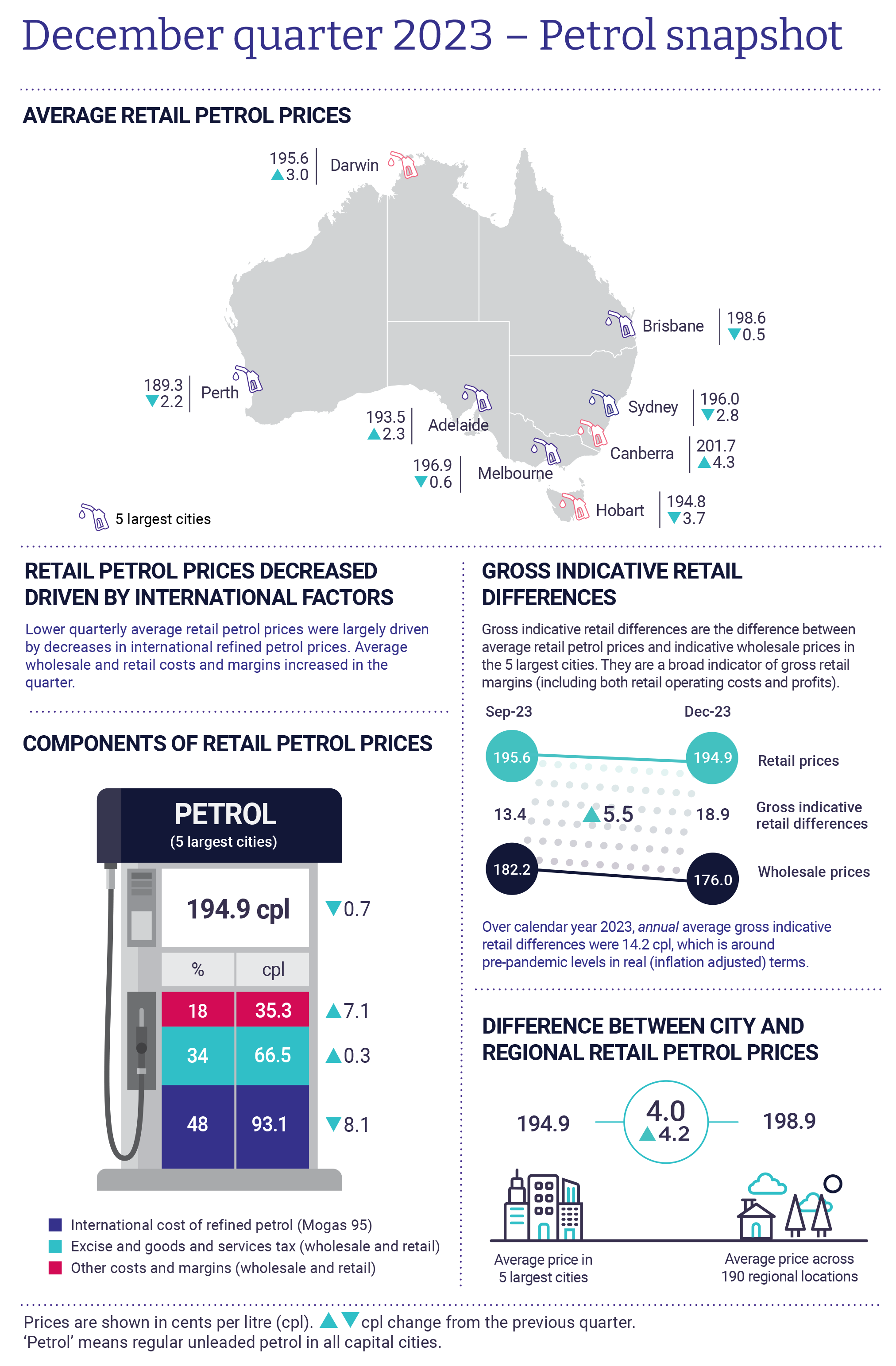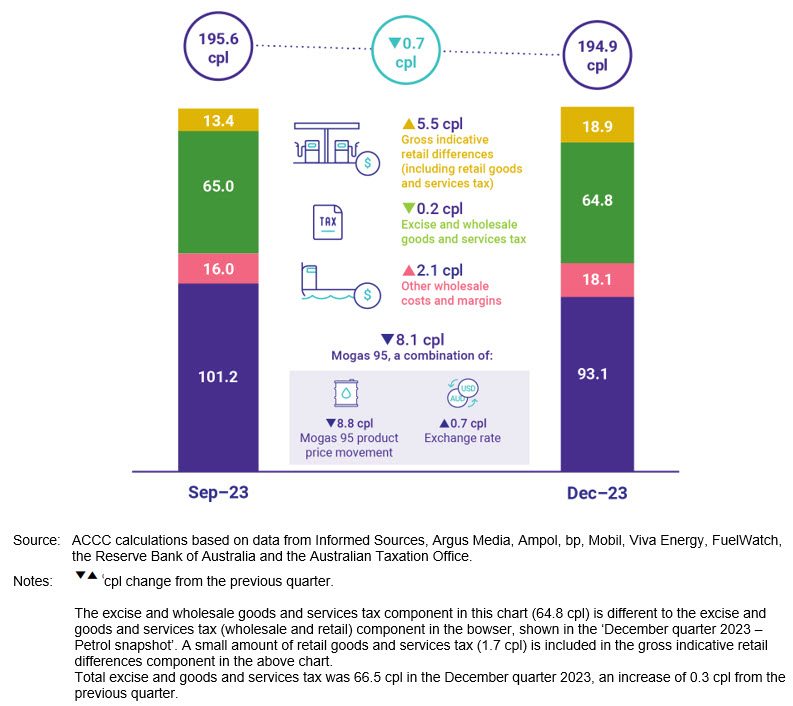 Click to enlargeRetail petrol prices in Australia’s five largest cities trended downward in the December quarter 2023 as international refined petrol prices decreased, according to the ACCC’s .
Click to enlargeRetail petrol prices in Australia’s five largest cities trended downward in the December quarter 2023 as international refined petrol prices decreased, according to the ACCC’s .
Quarterly average retail petrol prices in Australia’s five largest cities (Sydney, Melbourne, Brisbane, Adelaide and Perth) were 194.9 cents per litre (cpl), a decrease of 0.7 cpl from the September quarter 2023 (195.6 cpl).
Monthly average retail petrol prices in the five largest cities decreased from 206.6 cpl in September 2023 to 186.6 cpl in December 2023 (a decrease of 20.0 cpl or around 10 per cent).
“While average retail petrol prices in the five largest cities decreased in the quarter, they were still at relatively high levels after international factors drove average retail prices to the highest on record in nominal terms in the September quarter 2023,” ACCC Commissioner Anna Brakey said.
The following chart shows the increase in seven-day rolling average retail petrol prices in the five largest cities from January 2022 to December 2023.
Seven-day rolling average retail petrol prices in the 5 largest cities in nominal terms: 1 January 2022 to 31 December 2023 – cents per litre (cpl)

“Average retail petrol prices in the five largest cities have generally trended upwards in January and February 2024 on the back of higher international benchmark prices in the first two months of the year,” Ms Brakey said.
“We encourage motorists to take advantage of fuel price apps and websites which provide near real-time fuel price information to find lower priced petrol.”
“Motorists in the five largest cities can stay informed about petrol price movements and refer to price charts on the ACCC website to help them fill up when prices appear to be around the lowest point in the cycle,” Ms Brakey said.
“Even when petrol prices are not around a low point of the price cycle, using apps and websites to shop around can make a difference.”
Lower international petrol benchmark prices were the main contributor to lower retail prices in the quarter
Changes in Australian retail petrol prices are largely determined by international refined petrol prices that are driven by international crude oil prices, and the AUD-USD exchange rate. The price of Singapore Mogas 95 Unleaded (Mogas 95) is the price of refined petrol in the Asia-Pacific region and is the relevant benchmark for petrol prices in Australia.
Crude oil and Mogas 95 prices were lower in the December quarter 2023. The decrease in crude oil prices resulted from weaker demand and slowing economic growth combined with increased oil production in the United States, countering declining supply from the OPEC cartel countries and Russia.
The following chart shows that average Mogas 95 prices, in Australian cents per litre, decreased by 8.1 cpl in the quarter. Other components of retail prices shown in the chart include excise and wholesale goods and services tax, wholesale costs and margins (including international shipping costs and other import costs, and wholesale costs and margins) and retail costs and margins (represented by gross indicative retail differences).
“On a quarterly average basis, the impact of the lower Mogas 95 prices was partly offset by a lower AUD-USD exchange rate, higher wholesale costs and margins and higher gross indicative retail differences,” Ms Brakey said.
Changes in the components of average retail petrol prices in the 5 largest cities: September quarter 2023 to December quarter 2023 – Australian cents per litre (cpl)

Increase in the quarterly average gross indicative retail differences
Quarterly average gross indicative retail differences increased in the five largest cities by 5.5 cpl to 18.9 cpl in the December quarter 2023.
Over calendar year 2023, annual average gross indicative retail differences were 14.2 cpl, which is around pre-pandemic levels in real (inflation adjusted) terms. Between March 2017 and December 2019, real 12-month average gross indicative retail differences ranged between 14.0 cpl and 15.0 cpl.
Gross indicative retail differences are the difference between average retail prices and average wholesale prices, and they broadly indicate gross retail margins. They do not account for retail operating costs and should not be interpreted as actual retail profits.
Quarterly average gross indicative retail differences can be influenced by lags between the timing of changes in wholesale prices (terminal gate prices) and changes in retail prices. These effects are less prevalent when gross indicative retail differences are considered over a longer period.
“While the longer-term gross indicative retail differences are broadly in line with pre-pandemic levels, we will continue to keep a close eye on them,” Ms Brakey said.
Retail diesel prices trended downward as international diesel benchmark prices decreased
Seven-day rolling average retail diesel prices in the five largest cities trended downward during the December quarter 2023. Prices were 221.9 cpl at the beginning of the quarter and decreased to 190.2 cpl at the end of the quarter.
“The easing of a global diesel shortage and the softening of demand from the slowdown in manufacturing and construction activity along with the shifts in crude oil prices influenced lower international diesel benchmark prices during the December quarter 2023,” Ms Brakey said.
Quarterly average retail petrol prices increased in Canberra, Darwin and in regional locations
The ACCC monitors fuel prices in all capital cities and over 190 regional locations across Australia. In the December quarter 2023, average retail petrol prices in regional locations in aggregate (regional prices) were 198.9 cpl, an increase of 3.5 cpl from the September quarter 2023.
Quarterly average retail petrol prices increased in Canberra by 4.3 cpl and in Darwin by 3.0 cpl. In contrast, average retail petrol prices decreased in Hobart by 3.7 cpl.
Quarterly average retail petrol prices in Canberra were 201.7 cpl, the highest among the eight capital cities. “There is often a range of prices available, and the ACCC encourages motorists in Canberra to use the FuelCheck app and website to shop around for lower priced retailers,” Ms Brakey said.
Petrol sales volumes increased in the December quarter
Petrol sales volumes across Australia in the December quarter 2023 were 2,300 million litres, an increase of 4.5 per cent from the previous quarter, but still below pre-COVID-19 levels.
“Changes in driving habits, the increase in sales of hybrid and electric vehicles and motorists not buying as much petrol as they did in the past due to working from home and vehicles becoming more fuel efficient are likely reasons why petrol sales volumes have not fully returned to pre-COVID-19 levels,” Ms Brakey said.
Note
‘Petrol’ means regular unleaded petrol (RULP) unless otherwise specified.
Singapore Mogas 95 Unleaded (Mogas 95) is the relevant international benchmark for the wholesale price of petrol in Australia. Singapore Gasoil with 10 parts per million sulphur content (Gasoil 10 ppm) is the international benchmark for the wholesale price of diesel.
Background
The ACCC has been monitoring retail prices in all capital cities and over 190 regional locations across Australia since 2007.
On 14 December 2022, to the ACCC to monitor the prices, costs and profits relating to the supply of petroleum products in the petroleum industry in Australia and produce a report every quarter for a further three years.




